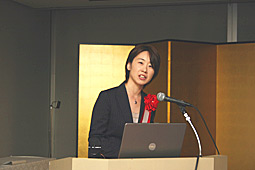 The 7th Iue Asia Pacific Research Prize Winner: Setsuko Sonoda
The 7th Iue Asia Pacific Research Prize Winner: Setsuko Sonoda
Title of Dissertation: "A Historical Study of International Migration in the Nineteenth Century: Overseas Chinese in the Americas and Their Relationships with China"

- Winner: Setsuko Sonoda
-
- 【Career】
Setsuko Sonoda, associate professor at Kobe Women's University, is a specialist in modern Chinese history and migration studies. Trained in history at Okayama University, she awarded B.A. (1993) and M.A. (1997) degrees. Then she entered the Ph.D. program of Area Studies in the Graduate School of Arts and Sciences at the University of Tokyo and earned M.A. (1999) and Ph.D. (2007) degrees. She was Fox International Visiting Fellow at the Yale Center for International and Area Studies (2000-01); Research Fellow of the Japan Society for the Promotion of Science for Young Scientists (2001-03); Associate Researcher at Waseda University Institute of Asia-Pacific Studies (2003-05) and Assistant Program Officer of the Toyota Foundation (2005-06).
- 【Career】
Nina Glick Schiller, a social anthropologist in migration studies, began to promote the transnational migration paradigm in the early 1990s. This paradigm presents an immigrant transnational social field which straddles the receiving country and the sending country. While being involved in the political or social activities in their new country of residence, the immigrants also maintain personal ties with their families and remain politically, economically, religiously and culturally involved with their home country. Such transnational relationships of immigrants were sometimes even reinforced, especially the relationships with their home country.
My doctoral study is based on empirical historical research which examines the modernity of immigrants and a nation-state through several case studies on emigration from Guangdong Province in China to the Americas in the late 19th century. Besides developing Schiller’s transnational migration paradigm, this study reveals that Chinese officials created ties with the overseas Chinese communities through diplomatic channels and that China as the home country continuously affected to the immigrants’ lives abroad. Part I of this study explains the various backgrounds and international issues that were caused by the introduction of Chinese indentured laborers to the United States, Canada, Peru and Cuba. Part II discusses the process of how the Chinese merchants in those regions developed their residential districts into commercial communities up until the 1880s, and then how they built relationships between the Qing dynasty diplomats and consuls stationed in the Americas.
In examining the history of Chinese external migration, we can see that regional relationships in Southeast Asia or Japan were relatively uneventful. By contrast, from the early stages of their community formation, the Chinese immigrants in the Americas experienced severe conflicts and tumultuous events such as the coolie trade, the anti-Chinese movement or the enactment of the Chinese Exclusion Law. However, perusing the local historical materials of the Chinese in San Francisco, Victoria, Lima and Havana, it is clear that there were various kinds of merchants and various scales of finance within the Chinese commercial population, such as laborers-turned-businessmen, wealthy old-comer merchants from the San-Yi (Sam-Yap) area, shopkeepers, barterers and traders who came directly from Hong Kong or who re-migrated from San Francisco. The Chinese immigrant merchants’ steady commercial activities through which they tried to make a living implemented their upward social mobility and turned the residential districts of Chinese into “Chinatowns” as commercial communities. In such communities, some merchants who had amassed capital, popularity and a common recognition from the community members assumed the leadership positions of the self-governing bodies. After the establishment of the permanent professional diplomatic service in China in 1877 and the dispatch of ministers and consular representatives by the Qing dynasty, the Chinese officials had frequent contact with the Chinese communities in the Americas. Those officials created new quasi-official positions for those leading merchants, such as the executives of the sanctioning body, the Chinese Consolidated Benevolent Association, and the Merchant Director or Acting Consul. By taking up these new posts, the merchants enhanced their influence and achieved further social ascent within the Chinatowns. Through this process, the Chinese communities after 1878 institutionalized the leadership positions of the self-governing organizations and maintained community-wide networks. The Chinese immigrant communities after the 1880s began to regard their home country of China as the ultimate political and cultural authority.
The following phenomena indicated that the relationships built between Chinese officials and immigrant merchants worked to form a new trans-Pacific space in the modern history of China and the Americas. The national authority of China was tied to the individuals or the groups abroad. San Francisco was the hub of mobility which tied together the Chinese communities in the Americas and it created dynamic mobile societies. The Chinese merchants re-migrated to other Chinese communities and their activities there modernized the social structure of the Chinatown. The Chinese officials’ approaches and experience in overseas Chinese matters were transplanted to other immigrant communities. Chinese domestic reforms were implemented in the overseas Chinese communities and the new social strata in China’s coastal cities transmitted them. The early history of Chinese immigrants to the Americas illustrates the emerging Pan Pacific region of the movement of people.






